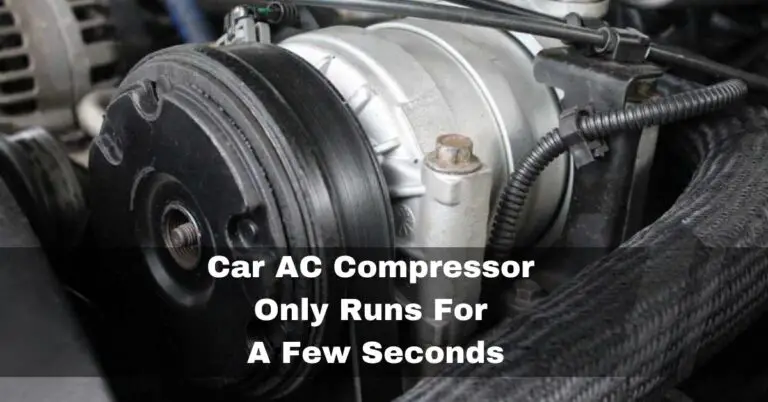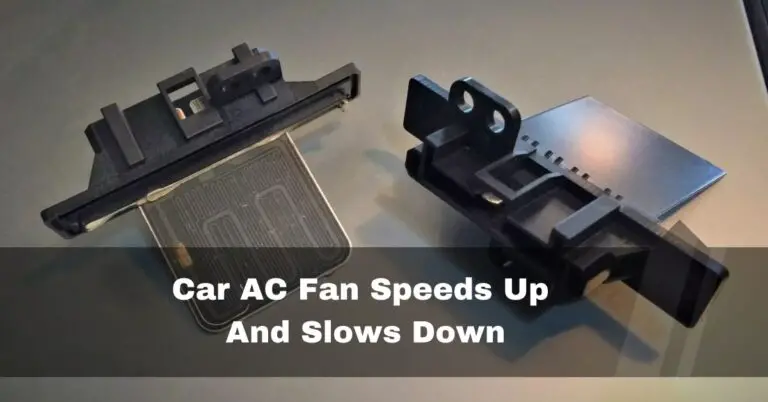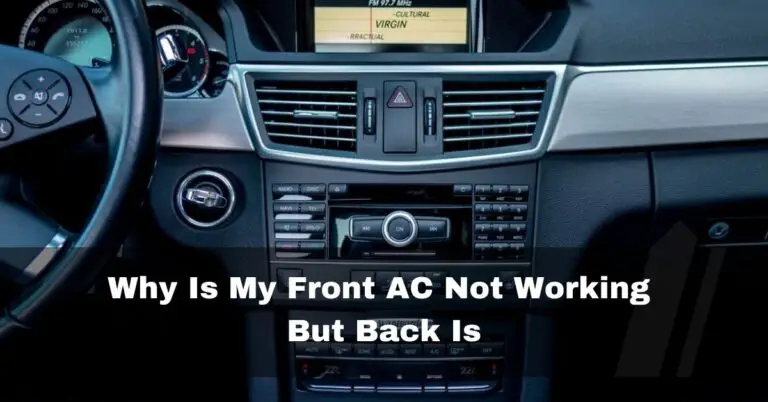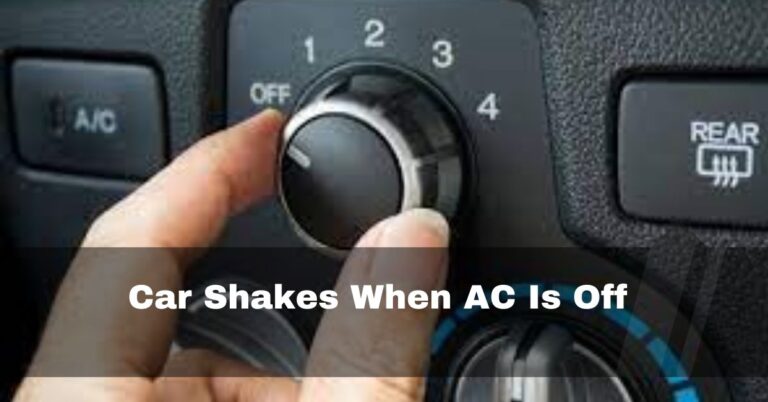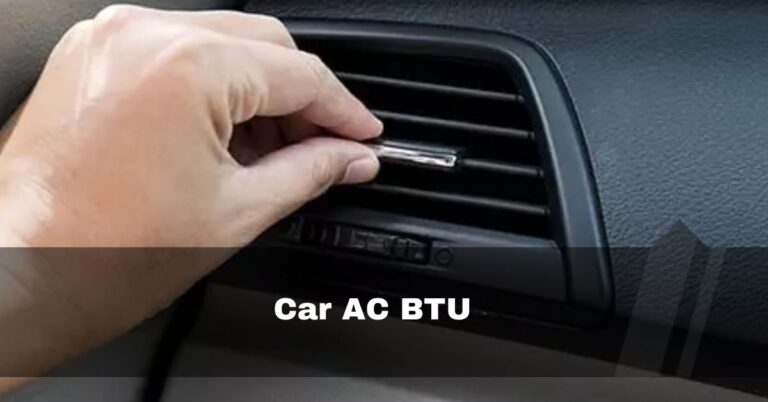White Smoke From Car AC Vent – 9 Easy Fixes In 2023
You’re driving down the road on a hot summer day, enjoying the cool comfort of your car’s air conditioning. Suddenly, you notice something unusual – white smoke blowing from the AC vents. While it might be concerning, this issue is more common than you think and can be caused by various factors.
When air is colder than the dew point, moisture forms, causing fog or smoke. Dirty filters or low fan speed worsen it.
In this article, we’ll delve into the potential causes of white smoke from car AC vents and explore the steps to address each issue.
Table of Contents
Why Does White Smoke From Car AC Vent? Explore Solutions:
1. Condensation:
Condensation is one of the most frequent reasons for white smoke coming from AC vents. The moisture in the air condenses into water droplets when the temperature around the AC unit is lower than the dew point. In the cabin, this condensation may appear like smoke or fog. It is particularly common in humid climates.
How To Fix:
There is no need to act because this is a natural occurrence. The condensation will vanish as the automobile’s interior cools and the air inside reaches a more comfortable temperature.
2. Car Overheating:
The main and most immediate cause of smoke from a car’s vents is frequently connected to an overheated engine. Continuous long-distance driving can raise the temperature in the engine and other parts of the car.

The condition may lead to the visible emission of smoke via the vents when these components heat up and the total water level in the car drops. The result of this event, which manifests as smoke coming out of the vents, is a combination of elevated engine temperatures and a decrease in readily available water.
How To Fix:
Take care of the root cause of the overheating, which may require inspecting the thermostat, radiator, water pump, and coolant level. Engine overheating can be avoided with routine maintenance and prompt repairs.
3. Overuse Of Heater:
Excessive heater use is another clear cause of smoke from your car vents. A heater core compromised by overuse may leak due to the weakened core. The creation of smoke due to this leakage within the core may cause it to be visible via the vents. It’s important to note that the coolant level has noticeably dropped when smoke lacks any odor and has a fog-like appearance.

How To Fix:
When the heater core leaks, it frequently results in smoke from the automobile vents. The best action in this situation is to swap out your old heater core for a new one. However, if you cannot buy a new core, you can hire a specialist to examine it, identify the leak, and repair it.
4. Low Oil Level:
Smoke may be formed in your car if you’ve been running the air conditioner frequently and have yet to check the oil level. Although there are additional causes, often operating the air conditioner is the main one that results in low oil levels in your automobile.

How To Fix:
Check and maintain the engine oil level as directed by the manufacturer regularly. To guarantee appropriate lubrication and cooling, top off the oil as needed.
5. Clogged Drain Hole:
Condensation can exit the AC unit through a drain hole. White smoke may occur if this drain hole is plugged in because it might cause water to back up and combine with air.

How To Fix:
Get rid of the water in the heater box as a first step in stopping smoke from venting from your car. Recall how we mentioned that a blocked drain hole could produce smoke. Therefore, removing the water from the heater box may be the solution.
Locate the HVAC box drain pipe, the conduit through which the heater box discharges water. You can use a pump to remove the water from the pipe if you are certain that the water within is the smoke’s source. Alternatively, you could clear the clog by cutting the curve out of the pipe. It should make the problem go away.
6. Worn Out Car Components:
Smoke may occasionally come from the vents if some internal automotive components need to be updated and more effective. If you last had your automobile serviced a while ago, one of its inner components may start to malfunction, which could cause smoke to appear from the vents.

Your car’s interior may become overheated due to this broken component. And as we previously discussed, that can cause smoke. You might even smell anything burning inside your car if this is happening.
How To Fix:
Check the various electric cables in your automobile for another solution to this issue. The battery cables may cause smoke to emanate from the vents if they are rusted or not connected properly.
Check all of the cable connections and tighten any that are loose. If you discover any broken or damaged cables, you can replace them to address the problem right away.
7. Malfunctioning Compressor Clutch:
A broken compressor clutch might cause the AC system to operate improperly, resulting in white smoke from coolant or refrigerant entering the wrong portions of the system.

How To Fix:
If smoke comes from your automobile vents due to a damaged or problematic compressor clutch, replacing it may be your only option. Due to the complexity and cost of clutch repair, it is not feasible.
8. High Humidity:
You might immediately notice fog pouring out of the AC vents if the air around your car’s air conditioner is less humid than the air inside the rest of the vehicle. Unlike smoke, fog has a very cold feeling. While fog feels chilly and makes you think shivery, the smoke has a burning smell.
How To Fix:
Cleaning the air filters is a quick cure if smoke flows from your car vents due to the dampness close to the AC vents. Make the humidity surrounding the vents more consistent with the rest of the car by cleaning the filters.
Another option is to utilize a powerful fan inside your automobile. You can also stop the smoke from escaping from the vents by briefly setting the AC inverter’s temperature to hot.
9. Damaged Oil Filler Cap And Oil Leakage:
If the cap you use to seal the oil in your car is damaged, the fuel may leak out of its intended location. When this occurs, the power is burned in the car’s engine, which may result in smoke. Your car may suffer terrible consequences if you don’t rapidly resolve this issue.

How To Fix:
Make the oil filler cap in good shape and properly sealed. Once you’ve been driving your car for a time, you’ve probably heard others mention getting an “oil change.” Although it may not seem essential, your automobile must function properly. If it’s been a while since you changed the oil in your car, you should do it as soon as you can.
What Are Different Types of Smoke That Comes Out of Car Vents?
1. Blue Smoke:
There are two main reasons why blue smoke, a blatant indicator of oil burning, could be present. Blue smoke is first released due to an oil spill into the combustion chamber. Second, oil might burn inside the engine, producing blue smoke due to the deterioration of vital parts like piston rings or valve seals.
A dual strategy is needed to solve this problem. First and foremost, it’s important to stop oil leaks and check oil levels. Blue smoke can be considerably decreased by performing routine maintenance and promptly fixing oil leaks.

Second, getting expert help becomes crucial if the primary culprit is worn piston rings or valve seals. It’s a challenging process that normally necessitates the knowledge of skilled technicians to replace these broken components. Because of this, it’s frequently important to rely on professional expertise to solve the problem and stop the occurrence of blue smoke.
2. Black Smoke:
Black smoke’s appearance, distinguished by its dark color, is frequently related to several factors throughout the combustion process. One of the main causes is a fuel-rich mixture, which occurs when an excessive amount of fuel and insufficient air combine during combustion to produce black smoke.
Incomplete combustion may also result from obstructed airflow brought on by clogged air filters, which adds to the production of black smoke. Additionally, damaged sensors might alter how precisely the air-fuel mixture is balanced, aggravating the problem and producing black smoke.

A systematic approach to each cause is necessary to address this issue. A thorough fuel system analysis is needed to remedy a fuel-rich mixture. Finding and fixing systemic problems might aid in reestablishing the ideal air-fuel ratio and lessen the occurrence of black smoke. Similarly, routine maintenance is essential when dealing with blocked air filters.
Air filters that are changed or cleaned on schedule can improve airflow, encourage complete combustion, and reduce the formation of black smoke. Finally, repairing or recalibrating these parts when sensors are malfunctioning is crucial. Ensuring the air-fuel mixture is accurately measured and regulated can greatly reduce the issue of black smoke production.
3. Grey Smoke:
Grey smoke, which has a distinctive color, might result from particular aspects of vehicle functioning. Burning transmission fluid, which happens when the fluid gets too hot, is one of the main causes. As a visible result of this high temperature, grey smoke is produced. Similarly to that, burning brake fluid also has grey smoke. Grey smoke is produced when brake fluid escapes onto heated engine components.

Targeted solutions are required to address this issue. Whenever transmission fluid burns, a two-step procedure is advised. It is essential to start by checking the transmission fluid levels. Low amounts can make overheating worse. The second stage involves addressing the primary source of overheating, which can entail checking and maintaining the transmission system.
Like burning brake fluid cases, repairing the leak’s source is crucial. Grey smoke can be avoided by performing timely repairs and maintenance to keep brake fluid from coming into touch with heated engine components. Maintaining adequate brake fluid levels also helps stop leaks and the subsequent emission of smoke.
FAQs:
Is It Safe To Drive With Smoke Coming From Car Vents?
No, it is not advised to drive while smoke is flowing from your auto vents. No matter what color the smoke is that you are witnessing, it is best to pull over and assess the situation before continuing to move your automobile. This smoke has serious health risks and may even be fatal to you. So it’s advisable to avoid driving with smoke coming from your vents if you don’t want to burn your car to the ground.
Can Run The AC On A Hot And Humid Day Cause White Smoke?
Yes, It is true that operating the air conditioner on a hot, muggy day may result in white smoke because of the temperature difference between the inside and exterior of the automobile. When humid air is in contact with a cold air conditioner, moisture in the humid air may condense and look like smoke.
Conclusion:
White automobile exhaust smoke Condensation and engine problems are just two examples of the many things that might lead to AC vents. It’s critical to pinpoint the precise cause to solve the issue in your situation. Your car’s air conditioning system may operate efficiently and smoke-free with routine maintenance, prompt repairs, and professional assistance when necessary, resulting in a comfortable and safe driving experience.

